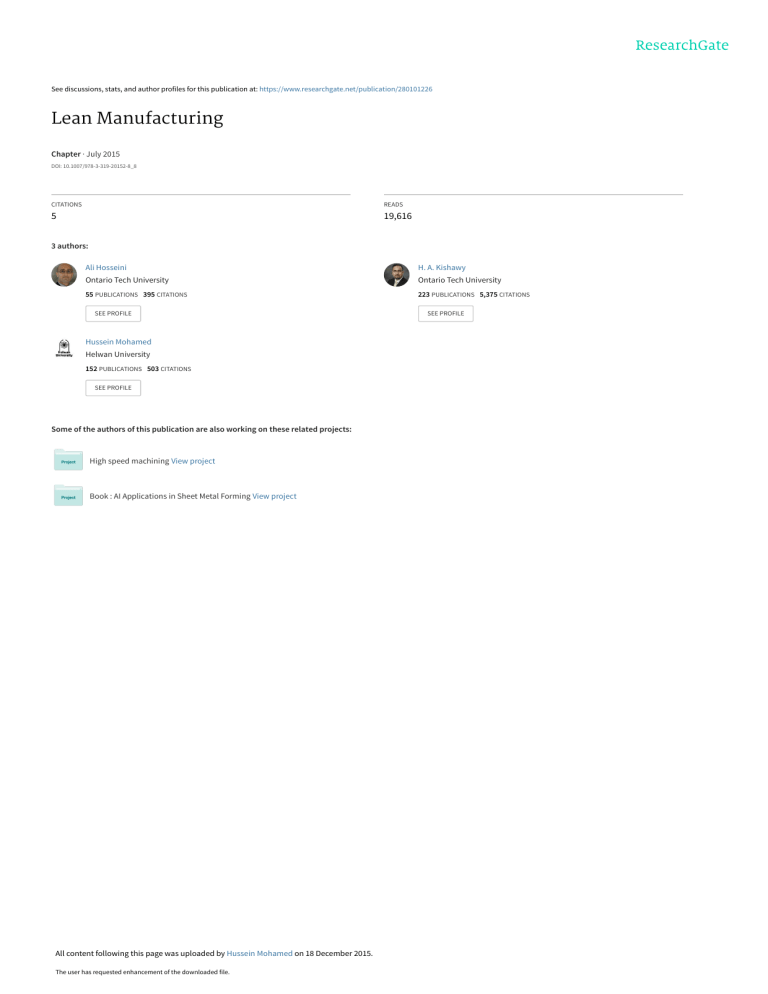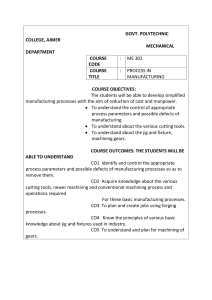
See discussions, stats, and author profiles for this publication at: https://www.researchgate.net/publication/280101226 Lean Manufacturing Chapter · July 2015 DOI: 10.1007/978-3-319-20152-8_8 CITATIONS READS 5 19,616 3 authors: Ali Hosseini H. A. Kishawy Ontario Tech University Ontario Tech University 55 PUBLICATIONS 395 CITATIONS 223 PUBLICATIONS 5,375 CITATIONS SEE PROFILE Hussein Mohamed Helwan University 152 PUBLICATIONS 503 CITATIONS SEE PROFILE Some of the authors of this publication are also working on these related projects: High speed machining View project Book : AI Applications in Sheet Metal Forming View project All content following this page was uploaded by Hussein Mohamed on 18 December 2015. The user has requested enhancement of the downloaded file. SEE PROFILE Preface Nowadays, Manufacturing Engineering is defined as a discipline “which involves the ability to plan the processes and practices of manufacturing and to research and develop systems, processes, machines, tools and equipment for producing quality products”. Manufacturing is the “art” of transformation of materials into products. Fundamental subjects of manufacturing engineering include: materials technology, forming and sheet metal working, traditional and non-traditional machining, joining and assembly processes, automation and manufacturing systems, green and lean manufacturing, etc. The purpose of this book is to present a collection of examples illustrating research in “Modern Manufacturing Engineering”. Chapter 1 of the book provides submicro- and nanostructuring of materials by severe plastic deformation. Chapter 2 is dedicated to cross rolling (a metal forming process). Chapter 3 describes a finite element method in machining processes. Chapter 4 contains information about machining and machining modelling of metal matrix composites. Chapter 5 contains information about intelligent CNC tool path optimization for sculptured surface machining through virus-evolutionary genetic algorithm. Chapter 6 is dedicated to friction stir welding: (scope and recent developments). Chapter 7 describes innovative joining technologies based on tube. Chapter 8 contains information about lean manufacturing. Chapter 9 provides object-based final-year project (designing and manufacturing a quick stop device). Finally, Chap. 10 is dedicated to quantifying quality of learning during teaching an undergraduate unit (manufacturing processes). This book can be used as a research book for final undergraduate engineering course or as a topic on manufacturing engineering at the postgraduate level. Also, this book can serve as a useful reference for academics, researchers, mechanical, manufacturing, industrial and materials engineers, professionals in manufacturing and related industries. The scientific interest in this book is evident for many important centres of research, laboratories and universities as well as industry. Therefore, it is hoped this book will inspire and enthuse others to undertake research in manufacturing engineering. v vi Preface The Editor acknowledges Springer for this opportunity and for their enthusiastic and professional support. Finally, I would like to thank all the chapter authors for their availability for this work. Aveiro, Portugal May 2015 J. Paulo Davim Contents 1 Submicro and Nanostructuring of Materials by Severe Plastic Deformation . . . . . . . . . . . . . . . . . . . . . . . . . . . . . . . . . . Viktor P. Astakhov 1 2 Cross Rolling: A Metal Forming Process . . . . . . . . . . . . . . . . . . Matruprasad Rout, Surjya K. Pal and Shiv B. Singh 41 3 Finite Element Method in Machining Processes: A Review . . . . . Carlos H. Lauro, Lincoln C. Brandão, Sergio L.M. Ribeiro Filho, Robertt A.F. Valente and J. Paulo Davim 65 4 Machining and Machining Modeling of Metal Matrix Composites—A Review . . . . . . . . . . . . . . . . . . . . . . . . . . . . . . . Angelos P. Markopoulos, Ioannis S. Pressas, Ioannis G. Papantoniou, Nikolaos E. Karkalos and J. Paulo Davim 5 Intelligent CNC Tool Path Optimization for Sculptured Surface Machining Through a Virus-Evolutionary Genetic Algorithm. . . . . . . . . . . . . . . . . . . . . . . . . . . . . . . . . . . . . . . . . Nikolaos A. Fountas, Nikolaos M. Vaxevanidis, Constantinos I. Stergiou and Redha Benhadj-Djilali 99 143 6 Friction Stir Welding: Scope and Recent Development . . . . . . . . Rahul Jain, Kanchan Kumari, Ram Kumar Kesharwani, Sachin Kumar, Surjya K. Pal, Shiv B. Singh, Sushanta K. Panda and Arun K. Samantaray 179 7 Innovative Joining Technologies Based on Tube Forming . . . . . . L.M. Alves, C.M.A. Silva and P.A.F. Martins 231 vii viii Contents 8 Lean Manufacturing . . . . . . . . . . . . . . . . . . . . . . . . . . . . . . . . . Ali Hosseini, Hossam A. Kishawy and Hussein M. Hussein 9 Object-Based Final-Year Project: Designing and Manufacturing a Quick Stop Device . . . . . . . . . . . . . . . . . . A. Pramanik, Hem Sanghvi and A.K. Basak 271 Quantifying Quality of Learning During Teaching an Undergraduate Unit: Manufacturing Processes . . . . . . . . . . . A. Pramanik and M.N. Islam 301 Index . . . . . . . . . . . . . . . . . . . . . . . . . . . . . . . . . . . . . . . . . . . . . . . 319 10 View publication stats 249



